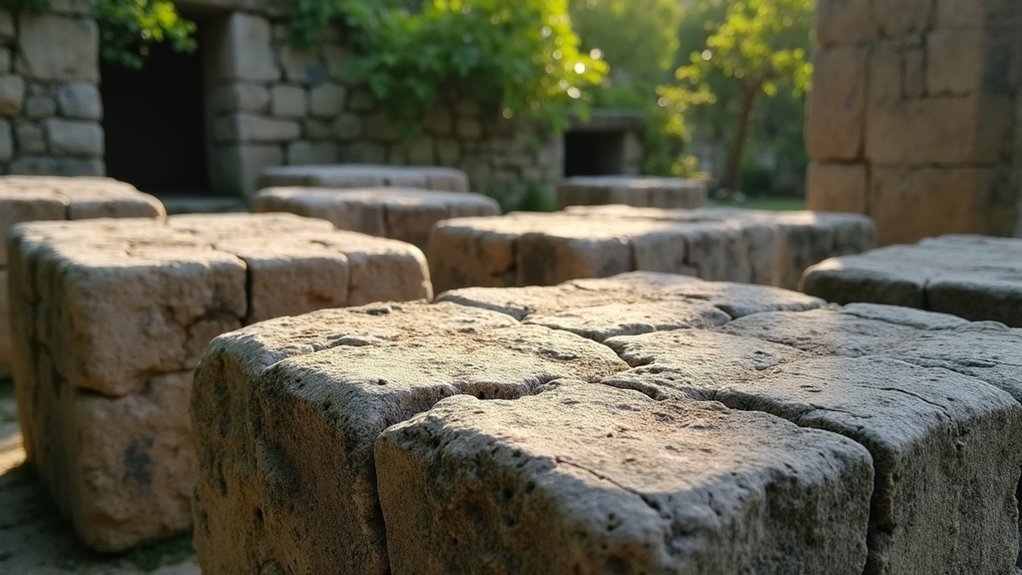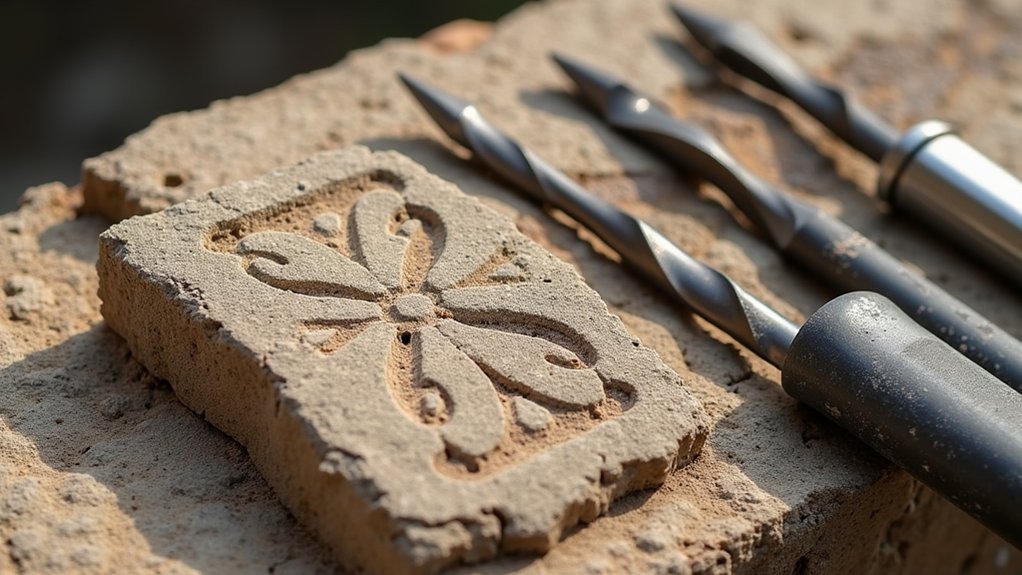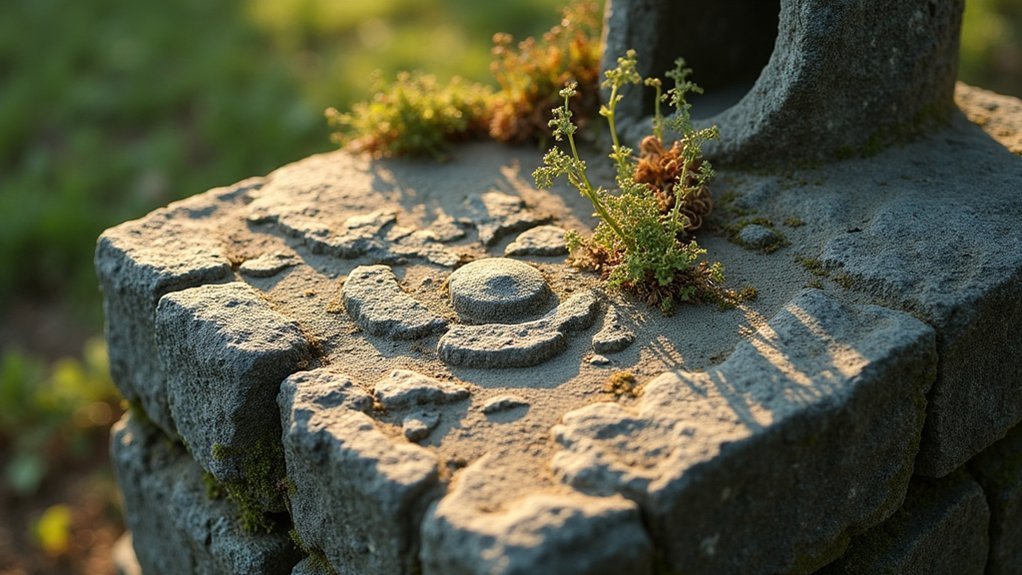You’re witnessing construction methods that modern engineers still can’t fully replicate when you examine the precision-cut granite blocks of ancient Egyptian monuments, where core drill holes show feed rates that exceed today’s industrial diamond-tipped equipment. These techniques created naturally climate-controlled structures through thermal mass properties, while their sustainable approaches minimize energy consumption. Understanding these methods reveals how ancient craftsmen achieved extraordinary precision that challenges conventional archaeological timelines and inspires contemporary applications.
Archaeological Evidence of Advanced Ancient Stone Working Technology

When you examine the archaeological record, you’ll discover compelling evidence that ancient civilizations possessed stone working technologies far more sophisticated than conventional history suggests.
Sir William Flinders Petrie’s core drill discoveries reveal precision that modern attempts can’t replicate. You’ll find drill holes at Karnak temple exceeding human hand diameter, demonstrating capabilities beyond current understanding.
Petrie’s core drill findings at Karnak demonstrate precision machining that surpasses modern replication attempts, revealing unexplained ancient technological capabilities.
The unfinished obelisk in Aswan shows advanced stone technology predating dynastic periods.
Granite boxes in Saqqara’s Serapeum exhibit extraordinary precision, indicating sophisticated tools mainstream archaeology hasn’t explained.
Complex granite stone artifacts on the Giza Plateau reveal multi-axis machining methods, proving ancient engineers understood advanced materials manipulation.
These discoveries challenge conventional timelines and suggest lost civilizations achieved remarkable technological sophistication in stone working.
The Engineering Mysteries of Egyptian Monuments and Obelisks
Although mainstream archaeology attributes Egypt’s monumental achievements to copper tools and human labor, the engineering realities of Egyptian obelisks and monuments reveal impossibilities that demand alternative explanations.
You’ll find Hatshepsut’s unfinished obelisk would’ve weighed 1,200 tons—beyond any known lifting capability.
The ancient Egyptians created core drill holes at Karnak exceeding hand-width diameter with precision that baffles modern engineers.
When you examine the Serapeum’s 70-tonne granite boxes, their surface accuracy challenges conventional archaeological perspectives.
Dolerite pounders couldn’t effectively shape granite due to similar hardness levels.
These stone structures display horizontal striations and advanced drilling patterns suggesting a level of technology predating dynastic periods, fundamentally reshaping our understanding of ancient engineering capabilities.
Precision Drilling Techniques That Puzzle Modern Engineers

The precision drilling evidence found throughout Egypt’s ancient sites presents engineering puzzles that confound modern experts attempting to replicate these achievements.
You’ll find drill holes at Karnak with diameters exceeding modern capabilities, featuring spiral grooves that indicate drilling efficiency we can’t match today. These precision drilling techniques produced thinner drill walls than 21st-century technology achieves, raising questions about ancient methods.
Key evidence challenging modern understanding includes:
- Granite cores with spiral grooves showing superior drilling efficiency
- Drill hole diameters larger than current engineering can produce
- Wall thickness measurements thinner than modern drill capabilities
- Non-hand tool evidence from Aswan’s unfinished obelisk
- 70-tonne granite boxes displaying impossible manufacturing precision
The mastery of granite and limestone processing thousands of years ago continues puzzling engineers worldwide.
Thermal Mass Properties and Natural Temperature Regulation in Ancient Architecture
Beyond their remarkable precision in stone cutting, ancient architects understood thermal dynamics in ways that created naturally climate-controlled environments.
When you examine structures like the Great Pyramid, you’ll discover how massive blocks of stone function as sophisticated temperature regulators. These thermal mass properties allow stone materials to absorb heat during day and release it slowly at night, maintaining stable indoor climates despite extreme external temperature swings.
Massive stone blocks in ancient pyramids act as natural thermostats, absorbing daytime heat and releasing it gradually through the night.
You’d find that granite and limestone blocks provide exceptional thermal insulation, reducing energy needs by up to 30% compared to modern materials.
Ancient builders unknowingly created sustainable architecture that required minimal heating or cooling. Their stone-cutting expertise wasn’t just about durability—it established energy-efficient living spaces that modern engineers still struggle to replicate without mechanical systems.
Cultural Significance of Stone in Ancient Civilizations and Religious Practices

While ancient builders mastered stone’s thermal properties for practical comfort, they also recognized its profound spiritual power across every major civilization.
You’ll find that stone transcended mere construction material, becoming a sacred bridge between earthly and divine domains.
Ancient Egyptians chose granite and limestone for their pyramids and temples to symbolize eternal connection with gods.
Greeks and Romans used marble to represent power and enlightenment in civic structures.
Native American cultures incorporated sacred stones into healing ceremonies, honoring their earth connection.
Asian traditions employed stone in religious architecture for meditation spaces.
- Stone symbolized permanence and divine connection in Egyptian monuments
- Marble represented civic pride and enlightenment in Greco-Roman culture
- Native Americans used sacred stones for spiritual healing practices
- Asian cultures created contemplative spaces through stone architecture
- Enduring landmarks preserve this cultural heritage today
Sustainable Building Practices Inspired by Historical Stone Applications
Ancient civilizations didn’t just create lasting spiritual monuments—they pioneered building practices that modern architects are rediscovering as solutions to today’s environmental challenges.
When you examine structures like the Great Pyramids, you’ll find that sustainable materials such as natural stone offer exceptional durability with minimal maintenance requirements. You can reduce your building’s energy consumption by up to 30% by leveraging stone’s thermal mass properties for energy-efficient heating and cooling systems.
Local sourcing strategies used by ancient builders minimized transportation emissions while supporting regional economies—principles that remain essential today.
You’ll also discover that historical techniques utilizing solar energy for stone cutting demonstrate how renewable energy integration can create harmonious relationships between construction practices and environmental stewardship.
Preserving Traditional Craftsmanship for Contemporary Jewelry Making

When you incorporate traditional stone cutting methods into contemporary jewelry making, you’re not just creating accessories—you’re preserving millennia-old craftsmanship that connects modern wearers to ancient cultures.
These ancient techniques offer distinct advantages that modern machinery can’t replicate. Hand polishing and lapidary work maintain each gemstone’s unique textures and natural characteristics, creating pieces with authentic aesthetic appeal.
You’ll find that traditional craftsmanship promotes sustainability by minimizing waste during the crafting process, utilizing each stone’s full potential.
Benefits of traditional stone cutting include:
- Enhanced natural textures and characteristics
- Reduced material waste promoting sustainability
- Creation of intricate, historically-inspired designs
- Development of bespoke, individualized pieces
- Deeper cultural connection and heritage significance
Frequently Asked Questions
How Did Ancient People Cut Stones so Precisely?
You’d use copper tools with abrasive sand, dolerite pounders, and precise drilling techniques. Ancient Egyptians mastered advanced methods including possible sunlight disaggregation and reflective materials, achieving precision that challenges today’s understanding of their capabilities.
What Is the History of Stone Cutting?
You’ll find stone cutting began 2.6 million years ago with basic hammerstones. You’d see Acheulean handaxes emerge around 1.76 million years ago, then Middle Stone Age innovations brought hafted points and specialized scrapers.
How Did They Carve Stone in Ancient Times?
You’d use bronze tools and dolerite pounders to shape granite, employ core drilling techniques for precision holes, and apply sunlight disaggregation methods. You’d also utilize reflective materials to enhance cutting efficiency beyond traditional hand tools.
What Did the Natives Use to Cut the Rocks They Used for Their Pyramids?
You’d find they used copper and bronze tools, dolerite pounders for precision work, and likely advanced core drilling techniques. The massive granite boxes suggest they’d developed sophisticated cutting methods we don’t fully understand today.
In Summary
You’ll discover that ancient stone cutting methods aren’t just historical curiosities—they’re blueprints for sustainable construction and precision craftsmanship. You can apply their thermal regulation principles to reduce energy costs, adopt their eco-friendly quarrying techniques, and learn from their unmatched precision drilling. You’re witnessing engineering wisdom that’s survived millennia, offering practical solutions for today’s environmental challenges and inspiring you to preserve these invaluable traditional skills for future generations.





Leave a Reply